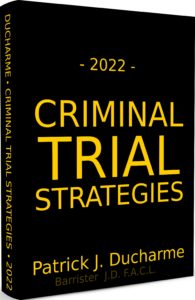Generally, in the absence of evidence raising serious concerns about the necessity or reliability of a statement or conduct, the utterances and conduct claimed to be admissible under this exception are admissible before the jury to be decided pursuant to the 3-step Carter procedure. Because the co-conspirators’ rule is a recognized, valid exception to hearsay, necessity and reliability are presumed in the absence of exceptional circumstances. The question is: what amounts to exceptional circumstances?
Iacobucci J. writing for the majority in Starr suggested that the circumstances would be rare. He wrote:
In some rare cases, it may also be possible under the particular circumstances of a case for evidence clearly falling within an otherwise valid exception nonetheless not to meet the principled approach’s requirements of necessity and reliability. In such a case, the evidence would have to be excluded. However, I wish to emphasize that these cases will no doubt be unusual, and that the party challenging the admissibility of evidence falling within a traditional exception will bear the burden of showing that the evidence should nevertheless be inadmissible. The trial Judge will determine the procedure (whether by voir dire or otherwise) to determine admissibility under the principled approach’s requirements of reasonable necessity and reliability.
It is important to remember that any consideration of reliability by a trial Judge in her capacity as gatekeeper on a voir dire as suggested here refers to threshold reliability, not ultimate reliability. Ultimate reliability is the responsibility of the trier of fact.
When the Supreme Court of Canada articulated what has come to be known as the principled approach to the admission of hearsay in Khan the traditional exceptions to hearsay were still maintained because each was based on a concern for reliability and necessity and could be reconciled with the new principled approach. As the Supreme Court of Canada explained in Mapara, the Starr decision provided the following framework for considering the admissibility of hearsay evidence:
a. Hearsay evidence is presumptively inadmissible unless it falls under an exception to the hearsay rule. The traditional exceptions to the hearsay rule remain presumptively in place.
b. A hearsay exception can be challenged to determine whether it is supported by indicia of necessity and reliability required by the principled approach. The exception can be modified as necessary to bring it into compliance.
c. In “rare cases”, evidence falling within an existing exception may be excluded because the indicia of necessity and reliability are lacking in the particular circumstances of the case.
d. If hearsay evidence does not fall under a hearsay exception, it may still be admitted if indicia of reliability and necessity are established on a voir dire.
Consequently, one basis for requesting that the court conduct a voir dire prior to the presentation of proposed evidence under the co-conspirators exception is where the indicia of necessity and reliability are lacking in the particular circumstances of the case. Defence counsel should expect that:
a. Prosecutors will likely argue that pursuant to Carter these issues should be left for the jury to decide;
b. Prosecutors will likely argue that Starr did not conclude that these issues must be decided on a voir dire in light of Iacobucci J.’s comment that, “the trial Judge will determine the procedure (whether by voir dire or otherwise).” They may suggest a more informal procedure where counsel present their positions by argument rather than evidence on a voir dire.
To these, or any other arguments that prosecutors raise to suggest that trial judges should not interfere with a process that Carter says should be left solely to the jury, defence counsel will no doubt counter with arguments that the evidence does not actually fall within the exception, or, is not necessary because the declarant is available to testify, or, that there are serious concerns about the reliability of the evidence as described in Chang.
The above is the an excerpt of Patrick J Ducharme’s book, Criminal Trial Strategies, available at Amazon or in bulk through MedicaLegal Publishing.
Read or listen to the Preface and Introduction and subscribe to Patrick Ducharme’s Youtube Channel.

